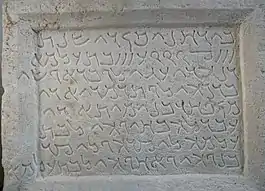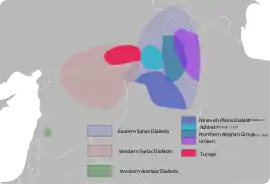Western Aramaic languages
The Western Aramaic languages represent a specific group of Aramaic languages, once spoken widely throughout the ancient Levant, from ancient Nabatea and Judea, across Palestine and Samaria, further to Palmyrene and Phoenicia, and into the Syria proper. The group was divided into several regional variants, spoken mainly by ancient Arameans and Jews. All of the Western Aramaic languages are today extinct, except Western Neo-Aramaic.[1]
| Western Aramaic | |
|---|---|
| Geographic distribution | Levant |
| Linguistic classification | Afro-Asiatic
|
| Subdivisions |
|
| Glottolog | west2815 |
Western Aramaic languages were distinctive from Eastern Aramaic languages, spoken in various eastern regions, throughout modern northeastern Syria, southeastern Turkey, northern Iraq, and northwestern Iran.
History

In the middle of the 5th century, Theodoret of Cyrus (d. c. 466) noted that Aramaic language, commonly labeled by Greeks as Syrian/Syriac, was widely spoken and also stated that "the Osroënians, the Syrians, the people of the Euphrates, the Palestinians, and the Phoenicians all speak Syriac, but with many differences in pronunciation".[2] Theodoret′s regional differentiation of Aramaic dialects included an explicit distinction between the "Syrians" (as Aramaic speakers of Syria proper, western of Euphrates), the "Phoenicians" (as Aramaic speakers of ancient Phoenicia), and the "Palestinians" (as Aramaic speakers of ancient Palestine), thus recording the regional diversity of Western Aramaic dialects (in Syria proper, Phoenicia and Palestine) during the late antiquity.[3][4]
Following the Arab conquests in the 7th century, and consequent cultural and linguistic Arabization of the Levant, Arabic language gradually replaced various Aramaic languages (including the Western Aramaic varieties) as the first language of most people.[5] Despite this, Western Aramaic appears to have survived for a relatively long time, at least in some villages in mountainous areas of the Mount Lebanon range and the Anti-Lebanon Mountains (in modern Syria). In fact, up until the 17th century, travelers in the Lebanon region still reported Aramaic-speaking villages.[6]
Present

Today, Western Neo-Aramaic is the sole surviving remnant of the entire western branch of the Aramaic languages,[7] spoken by no more than a few thousand people in the Anti-Lebanon of Syria, mainly in Maaloula, Jubb'adin and Bakhah. The speakers avoided cultural and linguistic Arabization due to the remote mountainous isolation of their villages.
See also
| Wikimedia Commons has media related to Western Aramaic languages. |
- Aramaic language
- Aramaic studies
- Bible translations into Aramaic
- Bible translations into Syriac
- Syriac language
- Syriac studies
- Syriac alphabet
- Syriac Christianity
References
- Beyer 1986, p. 46, 55.
- Petruccione & Hill, p. 343.
- Brock 1994, p. 149-150.
- Taylor 2002, p. 302-303.
- Griffith 1997, p. 11–31.
- Arnold 2000, p. 347.
- Arnold 2012, p. 685–696.
Sources
- Arnold, Werner (2000). "The Arabic dialects in the Turkish province of Hatay and the Aramaic dialects in the Syrian mountains of Qalamûn: Two minority languages compared". Arabic as a Minority Language. Berlin-New York: Walter de Gruyter. pp. 347–370.
- Arnold, Werner (2008). "The Roots qrṭ and qrṣ in Western Neo-Aramaic". Aramaic in Its Historical and Linguistic Setting. Wiesbaden: Harrassowitz Verlag. pp. 305–311.
- Arnold, Werner (2012). "Western Neo-Aramaic". The Semitic Languages: An International Handbook. Berlin-Boston: Walter de Gruyter. pp. 685–696.
- Beyer, Klaus (1986). The Aramaic Language: Its Distribution and Subdivisions. Göttingen: Vandenhoeck und Ruprecht.
- Brock, Sebastian P. (1971). "A Fragment of the Acta Pilati in Christian Palestinian Aramaic". The Journal of Theological Studies. 22 (1): 157–159.
- Brock, Sebastian P. (1989). "Three Thousand Years of Aramaic Literature". Aram Periodical. 1 (1): 11–23.
- Brock, Sebastian P. (1994). "Greek and Syriac in Late Antique Syria". Literacy and Power in the Ancient World. Cambridge: Cambridge University Press. pp. 149–160, 234–235.
- Creason, Stuart (2008). "Aramaic" (PDF). The Ancient Languages of Syria-Palestine and Arabia. Cambridge: Cambridge University Press. pp. 108–144.
- Gzella, Holger (2015). A Cultural History of Aramaic: From the Beginnings to the Advent of Islam. Leiden-Boston: Brill.
- Griffith, Sidney H. (1997). "From Aramaic to Arabic: The Languages of the Monasteries of Palestine in the Byzantine and Early Islamic Periods". Dumbarton Oaks Papers. 51: 11–31.
- Joosten, Jan (1991). "West Aramaic Elements in the Old Syriac and Peshitta Gospels". Journal of Biblical Literature. 110 (2): 271–289.
- Joosten, Jan (1992). "Two West Aramaic Elements in the Old Syriac and Peshitta Gospels". Biblische Notizen. 61: 17–21.
- Joosten, Jan (1994). "West Aramaic Elements in the Syriac Gospels: Methodological Considerations". VI Symposium Syriacum 1992. Roma: Pontificium institutum studiorum orientalium. pp. 101–109.
- Kim, Ronald (2008). "Stammbaum or Continuum? The Subgrouping of Modern Aramaic Dialects Reconsidered". Journal of the American Oriental Society. 128 (3): 505-531.
- Mengozzi, Alessandro (2011). "Neo-Aramaic Studies: A Survey of Recent Publications". Folia Orientalia. 48: 233-265.
- Morgenstern, Matthew (2012). "Christian Palestinian Aramaic". The Semitic Languages: An International Handbook. Berlin-Boston: Walter de Gruyter. pp. 628–637.
- Petruccione, John F.; Hill, Robert C., eds. (2007). Theodoret of Cyrus: The Questions on the Octateuch. 2. Washington: COA Press.
- Rubin, Rehav (2003). "Greek and Syrian Anchorites in the Laura of St. Firmin" (PDF). Aram Periodical. 15 (1–2): 81–96.
- Sokoloff, Michael (1990). A Dictionary of Jewish Palestinian Aramaic of the Byzantine Period. Ramat Gan: Bar Ilan University Press.
- Sokoloff, Michael (2003). A Dictionary of Judean Aramaic. Ramat Gan: Bar Ilan University Press.
- Sokoloff, Michael (2012). "Jewish Palestinian Aramaic". The Semitic Languages: An International Handbook. Berlin-Boston: Walter de Gruyter. pp. 610–619.
- Sokoloff, Michael (2014). A dictionary of Christian Palestinian Aramaic. Leuven: Peeters.
- Stevenson, William B. (1924). Grammar of Palestinian Jewish Aramaic. Oxford: Clarendon Press.
- Tal, Abraham (2012). "Samaritan Aramaic". The Semitic Languages: An International Handbook. Berlin-Boston: Walter de Gruyter. pp. 619–628.
- Taylor, David G. K. (2002). "Bilingualism and Diglossia in Late Antique Syria and Mesopotamia". Bilingualism in Ancient Society: Language Contact and the Written Word. Oxford: Oxford University Press. pp. 298–331.
- Wardini, Elie (2012). "Some aspects of Aramaic as attested in Lebanese place names". Orientalia Suecana. 61: 21–29.
- Weninger, Stefan (2012). "Aramaic-Arabic Language Contact". The Semitic Languages: An International Handbook. Berlin-Boston: Walter de Gruyter. pp. 747–755.
- Yildiz, Efrem (2000). "The Aramaic Language and Its Classification". Journal of Assyrian Academic Studies. 14 (1): 23–44.